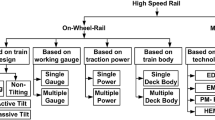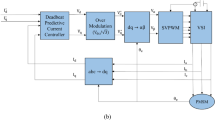Abstract
The eddy current braking (ECB) is often installed on heavy-duty vehicles as the auxiliary braking component. When it works for a long time, the thermal derating of braking torque will reach about 18.5 % due to high temperature. It is important to establish an accurate magneto-thermal coupling model for the ECB high-temperature steady-state braking torque prediction. In multi-field coupling calculation, there are two commonly used data transmission methods between two physics fields. One of them is transmitting average data to important geometry based on the idea of lumped parameters (lumped parameters method), and the other is mapping the data distribution to each grid cell (direct mapping method). This paper takes the ECB as the research object, analyzes the influence of the above two data transmission methods, and proposes to replace the fluid-thermal coupling model with the heat conduction model in the magneto-thermal coupling model. Through calculation and analysis, using the lumped parameters method to transmit the heat generation rate, temperature and convective heat transfer coefficient all have a certain impact on the calculation accuracy of the coupling model comparing with the direct mapping method.
Similar content being viewed by others
Abbreviations
- l :
-
equivalent length of the reluctance, m
- s :
-
equivalent sectional area of the reluctance, m2
- μ(B,T):
-
equivalent sectional area of the reluctance
- k T :
-
coefficient for temperature correction
- k m :
-
magnetic saturation coefficient
- Φ:
-
magnetic flux, Wb
- N :
-
the number of coil turns
- i :
-
the current of the coil, A
- t :
-
time, s
- E :
-
the electric field strength, V/m
- σ :
-
conductivity, S/m
- J :
-
the current density, A/m2
- ω :
-
frequency, rad/s
- Δ:
-
the skin depth, m
- α :
-
the thermal diffusivity, m2/s
- q v :
-
the heat generation rate, W/m3
- ρ :
-
density, kg/m3
- c :
-
the specific heat capacity, J/(kg·°C)
- k :
-
thermal conductivity, W/(m·°C)
- h :
-
heat transfer coefficient, W/(m2·°C)
- T i :
-
temperature, °C
- r i :
-
radius, m
- V :
-
volume, m3
- M :
-
the braking torque, Nm
- n :
-
rotating speed, RPM
- Q :
-
heat generation rate, W/m3
- q :
-
heat flux, W/m2
References
Davies, E. J. (1966). General theory of eddy-current couplings and brakes. Proc. Institution of Electrical Engineers 113, 5, 825–837.
Dietrich, A. B., Chabu, I. E. and Cardoso, J. R. (2001). Eddy-current brake analysis using analytic and FEM calculations. I. Theory. IEEE Int. Electric Machines & Drives Conf. (IEMDC). Cambridge, MA, USA.
Guo, W., Li, D. and Ye, L. (2019a). A model of magnetic field and braking torque in liquid-cooled permanent-magnet retarder accounting for the skin effect on permeability. IEEE Trans. Vehicular Technology 68, 11, 10618–10626.
Guo, W., Li, D., Ye, L., Gao, Z. and Zhang, K. (2019b). Performance analysis of a novel self-excited, liquid-cooled, and bridge integrated electromagnetic retarder for heavy vehicles with trailer. Int. J. Automotive Technology 20, 5, 1023–1032.
Jiang, W. and Jahns, T. M. (2014). Coupled electromagnetic -thermal analysis of electric machines including transient operation based on finite-element techniques. IEEE Trans. Industry Applications 51, 2, 1880–1889.
Jiao, B., Li, D., Du, X. and Zhang, K. (2014). Performance analysis and experimentation of a liquid-cooled eddy current retarder with a dual salient poles design. IEEE Trans. Energy Conversion 29, 1, 84–90.
Kim, H. K., Oh, Y. H. and Lee, S. H. (2009). Prediction of temperature rise in gas insulated busbar using multi-physics analysis. 2009 Transmission & Distribution Conf. Exposition: Asia and Pacific. Seoul, Korea.
Krings, A., Mousavi, S. A., Wallmark, O. and Soulard, J. (2013). Temperature influence of nife steel laminations on the characteristics of small slotless permanent magnet machines. IEEE Trans. Magnetics 49, 7, 4064–4067.
Liu, C., Jiang, K. and Zhang Y (2011). Design and use of an eddy current retarder in an automobile. Int. J. Automotive Technology 12, 4, 611–616.
Malti, M. G. and Ramakumar, R. (2007). Three-dimensional theory or the eddy-current coupling. IEEE Trans. Power Apparatus & Systems 82, 68, 793–800.
Moallem, M. and Jafari, R. (1998). Transformation method in the coupled FE magneto-thermal field analysis. IEEE Trans. Magnetics 34, 5, 3126–3129.
Pasnak, M. and Lundsten, R. (1960). High-temperature effects on magnetic core materials. Electrical Engineering 79, 5, 379–379.
Sharif, S., Faiz, J. and Sharif, K. (2012). Performance analysis of a cylindrical eddy current brake. IET Electric Power Applications 6, 9, 661–668.
Tian, J., Li, D., Ning, K. and Ye, L. (2020a). A timesaving transient magneto-thermal coupling model for the eddy current brake. IEEE Trans. Vehicular Technology 69, 10, 10832–10841.
Tian, J., Li, D. and Ye, L. (2020b). Study on braking characteristics of a novel eddy current-hydraulic hybrid retarder for heavy-duty vehicles. IEEE Trans. Energy Conversion 35, 3, 1658–1666.
Tian, J., Li, D., Ning, K., Ye, L., Zhang, K. and Hu, C. (2019). The study of the air gap optimization for the liquid-cooled and embedded eddy current retarder considering thermal deformation. 2019 IEEE Vehicle Power and Propulsion Conf. (VPPC). Hanoi, Vietnam.
Ye, L., Cao, M., Liu, Y. and Li, D. (2018). Multi-Field coupling analysis and demagnetization experiment of permanent magnet retarder for heavy vehicles. IEEE Access, 7, 50734–50745.
Ye, L., Li, D., Ma, Y. and Jiao, B. (2011). Design and performance of a water-cooled permanent magnet retarder for heavy vehicles. IEEE Trans. Energy Conversion 26, 3, 953–958.
Ye, L., Liu, Y. and Li, D. (2019). Performance analysis and optimization of liquid-cooled and flywheel-type eddy current retarder. IEEE Trans. Magnetics 55, 6, 1–5.
Zhang, K., Li, D., Du, X. and Zheng, R. (2014). Numerical analysis and experimentation of a novel self-excited and liquid-cooled eddy current retarder. IEEE Trans. Energy Conversion 29, 1, 196–203.
Zhang, K., Li, D., Zheng, R. and Yin, W. (2015). Design and performance of a self-excited and liquid-cooled electromagnetic retarder. IEEE Trans. Vehicular Technology 64, 1, 13–20.
Acknowledgement
The authors acknowledge the financial support from the National Natural Science Foundation of China under Project 51777003 and the Science and Technology Program of Beijing Municipal Education Commission under Project KM201710005010.
Author information
Authors and Affiliations
Corresponding author
Additional information
Publisher’s Note
Springer Nature remains neutral with regard to jurisdictional claims in published maps and institutional affiliations.
Rights and permissions
About this article
Cite this article
Tian, J., Li, D., Ning, K. et al. Research on the Data Transmission Methods in the Magneto-Thermal Coupling Model for Eddy Current Braking. Int.J Automot. Technol. 22, 1397–1407 (2021). https://doi.org/10.1007/s12239-021-0121-4
Received:
Revised:
Accepted:
Published:
Issue Date:
DOI: https://doi.org/10.1007/s12239-021-0121-4




